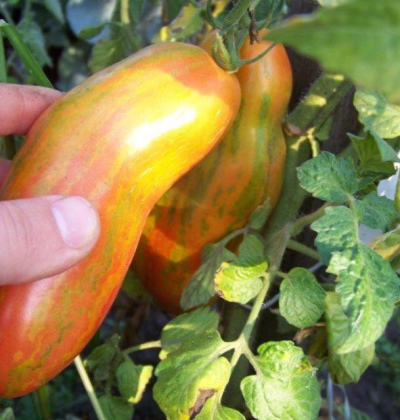
- Category: grade
- Growth type: determinant
- Appointment: universal
- Ripening period: mid-season
- Ripening time, days: 110-115
- Growing conditions: for open ground
- Bush size: tall
- Bush height, cm: 150-160
- Bush characteristic: powerful
- Unripe fruit color: light green with dark green stripes
Striped pepper is a highly productive tomato variety, distinguished by its original color, excellent taste and high yield.
Description of the variety
Determinate bush by type of growth, tall, powerful. Reaches a height of 1.5 to 1.6 m. The first inflorescences on the bushes are laid above 8-9 leaves, then they go in increments of 2 leaves. Each brush is capable of forming up to 9 ovaries.
The main qualities of the fruit
In accordance with the name, the fruits have a pepper-shaped, cylindrical shape, there is a characteristic sharp "nose". The colors of the tomatoes are interesting: in an unripe fruit, stripes of light green with dark green alternate, and ripe tomatoes are red, with a yellow stripe. Fruits are medium in size, their weight varies from 90 to 150 g. Length is from 10 to 12 cm. The flesh is firm, fleshy. There are 2-3-chambered fruits, the dry matter content is high.
Interestingly, the shape of tomatoes changes according to growing conditions. If you want to grow larger tomatoes, you should ration the number of ovaries.
Taste characteristics
The flesh is Pepper-like striped red, fleshy and sweet. Everyone notes the high taste of tomatoes.
Ripening and fruiting
The variety belongs to the mid-ripening group, since 110-115 days pass from the first shoots to the ripening of fruits. At the same time, fruiting is usually long-term.
Yield
The stable yield makes this variety stand out from the rest. It guarantees collection up to 7 kg / sq. m. However, with closer attention and careful care, you can achieve productivity up to 14-16 kg / m 2.
The timing of planting seedlings and planting in the ground
The variety in question is grown by the traditional seedling method. And all the components of this process are also traditional. Sowing of seeds takes place from late March to early April. Then the seedlings dive at the stage of 1–2 leaves, which is also quite common. Planting seedlings will differ depending on the place of cultivation: in greenhouses it will be May, in the ground - June.

Growing tomato seedlings is an extremely important process, because it largely depends on whether the gardener will be able to harvest at all. All aspects must be taken into account, from seedbed preparation to planting in the ground.
Landing scheme
For the comfortable growth of plants for each of them, it is worth allocating an area of 40x50 cm in the garden or greenhouse. Thus, from 3 to 4 seedlings are placed on 1 m 2 of the beds.

Growing and care
Seedlings of the Pepper striped are planted at 2 months of age, placed in a furrow or a separate hole. When planting on the bottom, it is necessary to place a layer of humus. It is necessary to deepen the seedlings at an angle so that the stalk touches the ground. Then the bush is covered with earth, then watered.
The variety must be formed: in greenhouse conditions, 1 stem should be left, in an open bed - 2-3.Step-sons are removed up to the 1st hand. It is also necessary to remove the leaves at the bottom of the bush. Cultivation of a variety includes a number of activities.
- Loosening the soil with parallel removal of weeds. This procedure can be eliminated by mulching the root circle.
- Garter to the support.
- Optimal watering. The soil should not dry out, but there should also be no stagnation of water.
- Fertilization with organic matter. When flowering, the plant requires phosphorus, during the ripening period of fruits - potassium.
- Top dressing stops 2 weeks before harvest.




A plant needs different micronutrients at each stage of growth. All fertilizers can be divided into two groups: mineral and organic. Folk remedies are often used: iodine, yeast, bird droppings, eggshells.
It is important to observe the rate and period of feeding. This also applies to folk remedies and organic fertilizers.
Disease and pest resistance
Striped pepper has excellent immunity to ailments such as tobacco mosaic virus, fusarium wilting, powdery mildew. The variety is tolerant to late blight.


Growing regions
This variety is bred especially for areas with risky farming. In the Urals, as well as in Siberia, it is possible to cultivate crops using a closed method.
In the Central region, in the regions of the middle zone of the Russian Federation, in the first half of the growing season, it is grown under film. When the night temperature does not drop below + 15 °, it can be removed. In the future, agricultural technology is the same as when growing outdoors.
Unfortunately, the variety is not so popular in the southern regions. This is due to the fact that the tomato is hygrophilous, and in hot climates voids will appear in the pulp, and cracks on the surface.

























































































